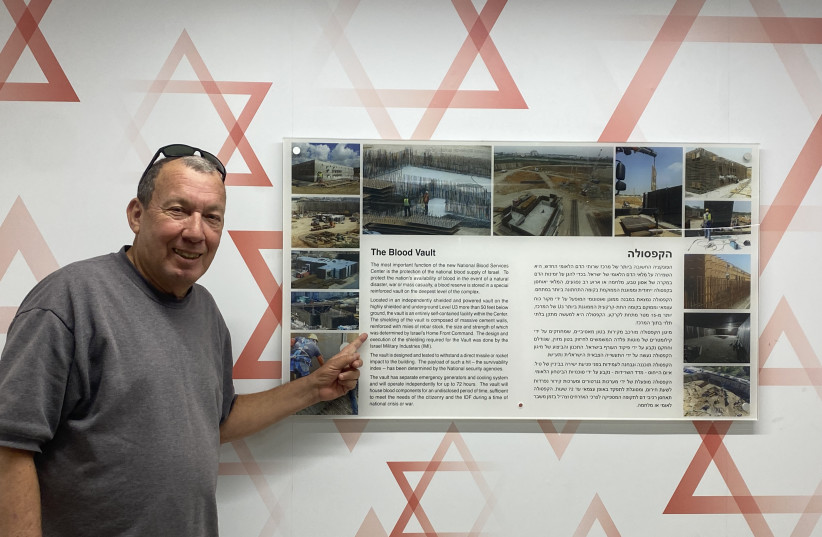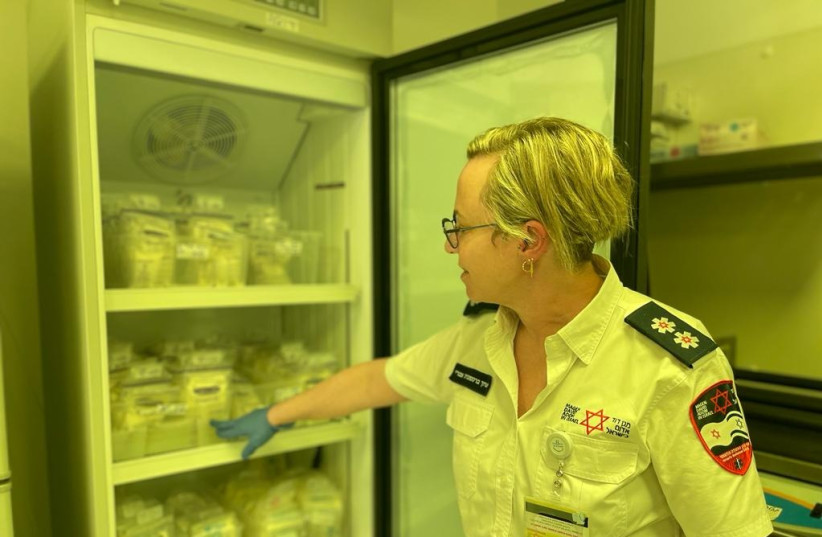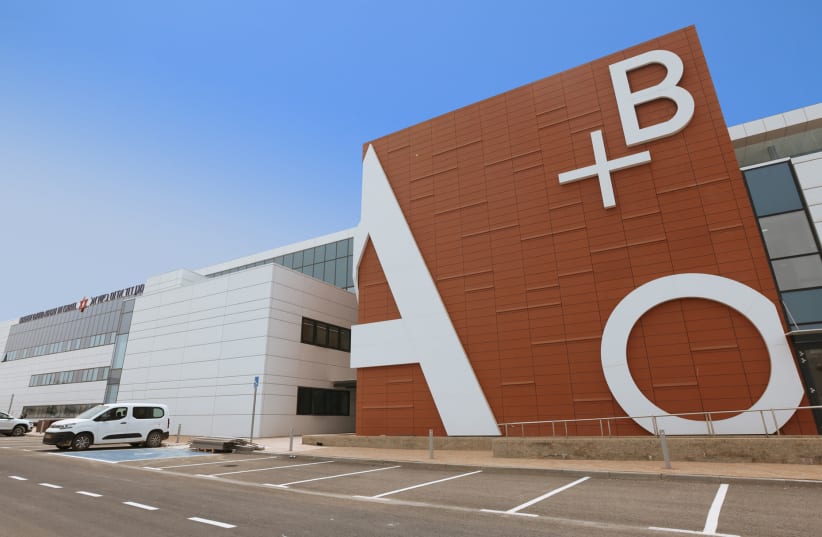Safeguarding national treasures isn’t a new concept for Israelis. But Magen David Adom’s brand-new blood center in Ramle takes security to a new level.
The center is an enormous facility with three underground, missile-proof levels and has been hailed as the most secure blood services center in the world.
“If you come here on a normal day, you will see civilians, paramedics, blood donors. It’s a civilian facility like in the US, but it’s more shielded, more secure.”
Moshe Noyovich
“If you come here on a normal day, you will see civilians, paramedics, blood donors. It’s a civilian facility like in the US, but it’s more shielded, more secure,” says Moshe Noyovich, the senior Israel representative for American Friends of Magen David Adom (AFMDA).
Far more secure. The blood banking at the Marcus National Blood Services Center is done in three increasingly deep and secure underground levels, ranging from roughly 7-15 m. in depth, which are protected by thick walls of concrete and steel. Additionally, the facility is safeguarded by numerous security redundancies such as extra vehicle ramps, power supplies, exits and blast doors.
The center, when fully operational (a status it expects to reach this March), will conduct all of Israel’s blood banking.


Why all this security?
In short, blood banking saves lives. Blood can be used for a variety of critical, and common, medical circumstances. Blood donations are separated into the component parts of plasma, red blood cells and platelets.
“Plasma is for loss of blood when you need to supplement volume. Red blood cells are needed primarily for surgeries. Platelets are more or less for clotting issues,” Noyovich explains.
There is always a need for blood, so having a facility that can store and stockpile it is vital. However, during wartime, the demand for blood rises dramatically. A shortage of blood can be devastating for a country’s war effort.
This makes blood banks appealing targets for enemy nations. For Israel, with all of the threats it faces, including rising tensions with Iran, a secure blood bank is an indispensable asset.
The previous MDA blood services center was totally insufficient in this regard, according to Noyovich. It was housed in a large glass building, built in 1987, which was beautiful and light, but was far from secure. So, during Israel’s recent wars, when rockets fell relatively close by, the most important equipment had to be taken to an underground area that normally functioned as a synagogue. For obvious reasons, this was not a situation in which the emergency medical apparatuses could continue to function.
The Marcus center solves all the security problems of the previous facility.
The first floor down has tens of thousands of square feet dedicated to laboratories, refrigeration and freezing. Furthermore, each of the five entries to the laboratories is marked by a vestibule with blast doors on either side. The labs also have blast windows that, when open, allow daylight in. The windows are the concrete vehicle ramps that descend from the surface and give the labs further protection.
“Those are the ramps leading to the underground floor, to the minus three level... again [there are] two ramps. Everything is doubled. One collapses, we use the other one; the other one collapses, we have three sets of elevators... it’s redundancy plus,” Noyovich says.
These laboratories will be responsible for analyzing the blood that comes into the facility and will do things such as check for contaminants and diseases.
The 1,200 sq.m. of refrigeration and freezing on this floor vary in temperature between rooms, but some rooms are as frigid as negative 22 degrees Fahrenheit. While the sheer size of this space dedicated to storing blood may seem staggering, the MDA center is prepared to make use of all of it.
Additionally, on the first floor underground, there is an area for dispatching MDA vehicles. “Hospital drivers will come through this airlock,” Noyovich explains, gesturing toward a room visible through a long glass window. There, drivers will be provided the needed supplies from an MDA worker on the other side of a window before continuing on to their destination. “Just like a [drive-through],” Noyovich jokes. “Take your box and leave.”
The MDA drivers will pass through the airlock from an adjacent gargantuan garage, approximately 20,000 sq.m., which can house ambulances. Especially during wartime, vehicles would be able to be safely stored, dispatched and repaired from this area.
The third floor underground is the most secure area in the entire facility.
“Floor number three is a logistics floor. We have plasma freezers and plasma fractionation,” Noyovich says. It also will house some of the facility’s most vital assets. As evidence, this floor contains what is simply referred to as “the vault.”
“In [the vault], we will store the strategic inventory of red blood cells for the whole State of Israel,” explains the AFMDA representative. “The vault is plated by these massive steel plates on the outside and the inside. It’s designed for a direct hit from a very, very big missile.”
The power connected to the vault, like everything else, has redundancies. In fact, electricity to the entire facility has a failsafe.
There are four massive generators that Noyovich speculates would be sufficient to power the entire city of Ramle. When in use, the noise they create is so deafening that the wall in front of them, comprised of large metal slats, is actually designed specially to dampen the noise.
“These [slats] are silencers... you don’t want to be around when [the generators] are on.” Noyovich chuckles.
“We have the biggest blast doors ever built in Israel to protect our generators,” he continues. Indeed, the hulking steel doors are incredibly thick and, even on well-oiled hinges, they are very heavy.
The facility also houses the main MDA logistics center for the entirety of the tiny Middle Eastern state. It helps facilitate the enormous technological and communications coordination that occurs within MDA.
Simplifying the MDA emergency apparatus
HAVING EVERYTHING under one roof greatly simplifies things for MDA emergency apparatus. It makes it possible, for instance, that when someone calls the emergency 101 number and describes the issue they are having, the center is immediately notified and is able to dispatch blood to the designated hospital.
Nearby is a massive warehouse full of basic supplies for ambulances and paramedics. Endless boxes are pre-packed with items such as disposable bedsheets, uniforms and even medication. In fact, right next to the storage area is a pharmacy.
If the “national dispatch center is the brain, the Marcus center is the heart,” Noyovich says. For an organization that gets over a million calls every year, it’s difficult to overstate the facility’s importance, especially in the event of a war.
The blood services center could be described as the pumping heart of Israel. It is vital that it be able to continue operating, even in the face of a chemical, biological or missile attack.
The facility was built with specific threats in mind. Israel’s National Security Council was involved in providing information on what kind of threat level the facility should be able to withstand.
The AFMDA director believes that the Marcus National Blood Services Center will serve as a model for the world.
“We’ve [received] delegations from Ukraine and Germany here... And I believe everyone would come eventually to learn how to protect their blood supply,” he says.
Noyovich, who has a background in engineering, has been at the forefront of the project to establish a secure blood bank from the outset. He’s been involved every step of the way.
“It’s the best gift someone can give to save a life. And you know, theoretically, every blood donation can save three people,” he says.
Apparently, the sentiment is widely shared. The initial funding of $135 million required to build the facility was supplied by donations, almost all of which were American in origin.
“You have to do things for the [soul],” Noyovich says. “Seriously. It’s not the money; it’s something that will save people’s lives... That’s the whole essence of this project: just to save people.” ■


Israel’s milk bank
The upper levels of the Marcus National Blood Services Center house the Sussman Family Foundation Human Milk Bank, the only one in the country.
Its director, Dr. Sharron Bransburg-Zabary, is a biochemist who began her focus on breast milk during her PhD studies.
“Human milk banking is considered to be the standard of care... in cases of premature infants below 32 weeks of gestation or below one and a half kilos, they should receive an exclusive diet of human milk, either the mother’s or a donor’s,” Bransburg-Zabary says. “This is why we are here: to help hospitals in Israel provide the standard of care to premature infants.”
Milk banks are vitally important for premature infants. In fact, Bransburg-Zabary speculates that Israel’s previous lack of a milk bank was a significant contributor to the state’s infant mortality rate. In recent years, however, Israel has begun to officially recognize the need for a milk bank, something Bransburg-Zabary believes should have occurred a while ago.
Around the world, “every 24 liters of donor milk saves the life of a premature infant below one and a half kilos,” she says. In Israel, where birth rates are high and mothers frequently don’t have the time or milk to spare, the need for the potentially life-saving liquid is particularly relevant.
“It’s like a magic potion,” the milk bank director says. “It has anti-inflammatory properties, it has growth components and other biological components that can help the infant.”
Furthermore, it is one of the best, most effective remedies an infant can get for all sorts of injuries and ailments. “You can see the healing process... A child that is unable to tolerate any food [will be able to] tolerate human milk,” Bransburg-Zabary explains.
According to Magen David Adom, the milk bank has doubled its capacity in 2022 after moving to the new facility.
